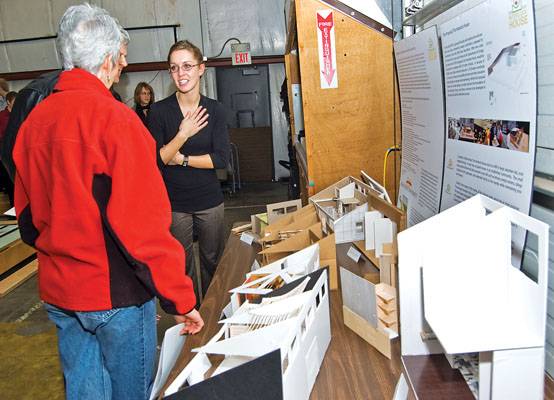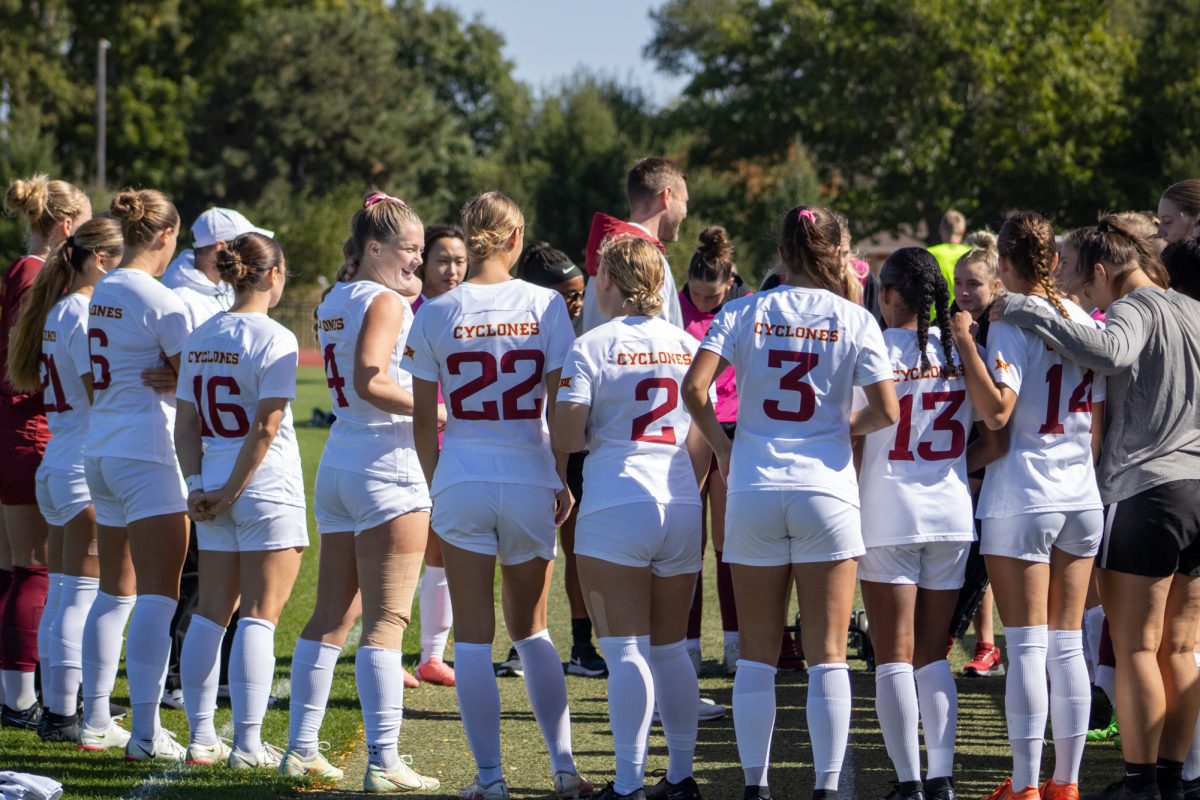Solar Decathlon team showcases design for innovative home

Jennifer Ross, graduate student in architecture, answers some questions about the scale models of the Interlock House, Saturday, January 31, 2009, at 1220 Southern Hills Drive. Ross is the project architect for the Solar Decathlon team, which hosted their official open house and ribbon cutting that day. Photo: Logan Gaedke/Iowa State Daily
February 1, 2009
Take a step into the house of the future.
The ISU Solar Decathlon team held an open house Saturday that showcased the sustainable innovations it has incorporated into the 800-square-foot Interlock House.
The team will be competing in the Department of Energy’s 2009 Solar Decathlon in October, a competition that challenges groups from across the globe to design a solar-powered home incorporating sustainable technologies.
This is the first time ISU students and faculty have entered the competition.
Forty-two teams sent proposals for the competition and only 20 made the cut. Teams head to Washington, D.C. on Oct. 1, and are given seven days to construct their home before they are judged.
“The big trick for a lot of these teams is designing a home that uses passive technologies related to our own location,” said Eric Smith, graduate student in architecture. “So the tilt of the roof, the orientation of the house and all these things are Iowan, as opposed to a team from Puerto Rico, would probably have a very different design to be comfortable in Puerto Rico.”
Smith said because the competition is held in Washington, D.C., teams have to design a home that works well in Washington D.C., where it will be judged, and in Iowa, where it will remain after the competition.
“So you have to really mix the two,” Smith said. “That’s a big design challenge for all of us.”
All the innovations going into the house serve at least two purposes. Along with using solar panels for electricity, the team has included innovations like replacing plastic parts with soy-based parts, using a corn-based insulation and a Warmboard floor. The floor has spaces for hot water pipes to run through, allowing heat to rise up from the floor.
Construction of the house began this semester in a warehouse at 1220 Southern Hills Drive. Aaron Brncich, construction project manager and graduate student in civil, construction and environmental engineering, has been teaching four classes of six students each where he directs students in construction of the home during the lab component of the course. Brncich also has four volunteer teaching assistants working with him.
“We want to have most of the structure, the shell of the house built by finals week,” Brncich said. “The completed house should be [done by] early- to mid-June.”
He said the team wants to get the house done early in the summer so they have a chance to take it apart and practice rebuilding it before transporting the house to Washington, D.C. for the competition.
“We only got a week, from October 1 to October 7, I believe, to get the house put together and ready for competition. So we need to make sure we have gotten all the kinks worked out and everything is running properly, set properly, a couple times at least before the summer is over.”
Brncich said he would like to have the team be able to rebuild the home in four days because energy consumption is monitored throughout the competition and if the home is finished in the first four days, the team’s meter is turned back to zero after the first week, before the house is shown.
Because of the size of the house, it cannot be transported in one piece.
“It’s a modular construction, with five different components of the house,” Brncich said. “There will be three floor components, two of them having walls, one of them having pop-up walls on site. So the east and west will be fully enclosed with appliances, furniture and plumbing already in it. The center section will have fold up walls that are assembled on site, because there’s nothing really overly complex that’s in it that can’t be done in a short amount of time.”
The house will also have a top portion with two east and west roof modules and a center portion also assembled on site, Brncich said.
“So we have the east and west parts if the house built ahead of time and the center part built on site with pre-cut and pre-fabricated materials,” he said.
Around 75 students have been involved in the planning, design and construction processes as well as the public relations of the project.
Mark Engelbrecht, dean of the College of Design, said the Solar Decathlon experience will benefit both students and faculty.
“This competition, the Solar Decathlon, has tremendous cache within the professional and design community. When you say to a perspective employer at an architecture firm, ‘Well, I was on the Solar Decathlon team in such and such a year,’ that’s something they remember,” Engelbrecht said. “It also provides a really interesting learning experience, not only for students, but also for faculty.”
Economic woes challenge Decathlon team
The ISU Solar Decathlon team is finding it harder to build a home in the downtrodden economy.
“Money wise, we’re just going through, as every company and business and people are in the States, we’re just trying to go through and really revamp our budget and cut out as much as we can,” said Chelsey Olsen, fundraising coordinator and graduate student in architecture. “It’s in flux right now, we’re just really cramming numbers to see what we can get away with as kind of the bare minimum, the worst case scenario, and just proceeding.”
Olsen said the team’s budget for the current year is $800,000. Money goes to graduate student salaries, transporting the house and site work when the house comes back to Iowa State. Because the budget is tight, Olsen said the team has been really seeking out in-kind gifts from different businesses. The gifts in kind allow the team to showcase the business’ product and save money for purchasing other items, like the photovalaic solar panels, that they cannot get as gifts in kind.
“There are just certain materials we need,” Olsen said. “We’re looking for duct work, drywall and a lot of counter finishes, doors, furniture, lumber continues to be something we need as a gift in kind. All of our appliances know we need a fridge, oven, dishwasher, washer and dryer, those sorts of units.”
Anyone wanting to contribute to the Solar Decathlon team can make donations at the teams Web site.
Involvement is university wide
With many departments contributing to Iowa State’s Solar Decathlon team, the university has come together to create an innovative home.
“I think the number of disciplines across campus is the distinguishing characteristic,” said Mark Engelbrecht, dean of the College of Design. “When I met with the other Big 12 deans that have gone through this, that was always their problem. It always just ended up in the architecture department. But here, we have a wide range of students and faculty that are involved with the project.”
Ulrike Passe, principal investigator and assistant professor of architecture, praised how many different disciplines were represented from across campus.
“We all work in a large team, which is quite significant and astonishing really,” Passe said. “We asked students at the beginning of this semester why they participated in this, because it’s more work for everybody, and they all said, first of all to get something real built during this curriculum, but also working with other disciplines.”
Engelbrecht said students looking for a job after graduation will have an advantage because they can say they worked with so many departments during this project.
“[Employers] know that it involves a process where they have to deal with the engineers, they have to deal with all the other constituents, they have to find the money and do the whole thing,” Engelbrecht said. “It’s a differentiating entry on your resume.”






